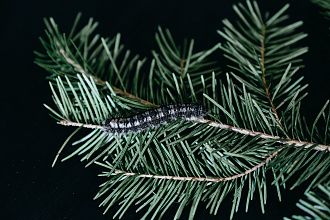Satellite data will predict the invasion of forest insect pests
23 September 2024 г.

One of the main reasons for the weakening and death of forests is the outbreak of pest insects. They occur in all major forest ecosystems and lead to significant economic and environmental losses due to the drying out and death of forests. These processes are especially intensive in the forests of the Northern Hemisphere. Climate change also contributes to the development of outbreaks. At the same time, ground-based surveys of pest numbers and assessment of the risk of their mass reproduction are difficult due to the large area and inaccessibility of Siberian forests. In addition, signs of weakening trees, deterioration of crown condition and damage to trunks are detected at late stages, when it is almost impossible to control pests. Therefore, forecasting insect outbreaks and increasing forest resilience should be the main tasks in pest control.
Scientists from the Krasnoyarsk Science Center of the Siberian Branch of the Russian Academy of Sciences, together with colleagues from Moscow and Novosibirsk, have proposed an original method for predicting outbreaks of insect pests in Siberian forests before visible damage to trees occurs. It is based on remote sensing data from satellites. "The only real way to assess the condition of forests over large areas is to use remote sensing data from satellites. The development of methods for predicting insect outbreaks is necessary, since it is important to determine the areas of future outbreaks of their numbers at least one or two seasons before the damage begins. Such information can improve prediction of future consequences and will allow the development of effective preventive measures in advance to reduce forest losses," says Vladislav Sukhovolsky, Doctor of Biological Sciences, Professor, Leading Researcher at the V.N. Sukachev Institute of Forest of SB RAS. The study was conducted using data on the numbers of the Siberian silkworm Dendrolimus sibiricus Tschetv, the white-spotted longhorn beetle Monochamus urussovi Fischer and the polygraphus proximus Blandford in the taiga forests of the Krasnoyarsk Region. In addition, the scientists studied one potential outbreak site in the Krasnoyarsk Region, where tree damage was not yet visible, but individuals of the Siberian silkworm were found in pheromone traps earlier developed by the scientists.
The proposed approach differs in being based on an assessment of the response of the plant photosynthetic system to changes in environmental conditions. The sensitivity parameter of the NDVI vegetation index to the temperature of the earth's surface is used as an indicator, which allows estimating the condition of plants and their response to climatic conditions.
The studies show that two years before visible damage to trees by insects, the response of trees to changes in the environment, in particular to soil temperatures, slows down. Thus, shifts in these parameters can serve as indicators of changes in the condition of forests and their response to external factors. The proposed indicator can be used to predict the invasion of insect pests. It can be used to predict the active spread of pests in a certain region and increase the efficiency of forest protection.
"Our task is to predict the centers of pest outbreaks before the trees are damaged. Moreover, in our case, the spectral characteristics of trees before the outbreak do not differ from the spectral characteristics of trees in the area where episodes of pest outbreaks did not occur. Therefore, to identify zones of future outbreaks, we used the reaction of spectral characteristics in response to temperature changes rather than the data of multispectral analysis. To evaluate the response functions, we needed to study the seasonal curves of the selected indicators. This is the peculiarity of our approach. The proposed method, which combines the sensitivity of the vegetation index with the temperature of the Earth's surface, is able to detect very early stages of an increase in the insect population before the damage becomes obvious, which allows for early measures to protect forests. At the same time, to evaluate the characteristics, we need a day of work on the computer without visiting the forest. This result opens up opportunities for assessing such parameters for any location covered with vegetation. Further research will probably help to more accurately assess the risk of an increase in the number of Siberian silkworms,” noted Vladislav Sukhovolsky.
Specialists from the Center for Forest Ecology and Productivity of the Russian Academy of Sciences (Moscow) and the Institute of Animal Taxonomy and Ecology SB RAS (Novosibirsk) also participated in the study. The study was supported by the Russian Science Foundation (grant No. 23-66-10015). The material was prepared with the support of a grant from the Russian Ministry of Education and Science within the framework of the federal project "Popularization of Science and Technology".
Share:


